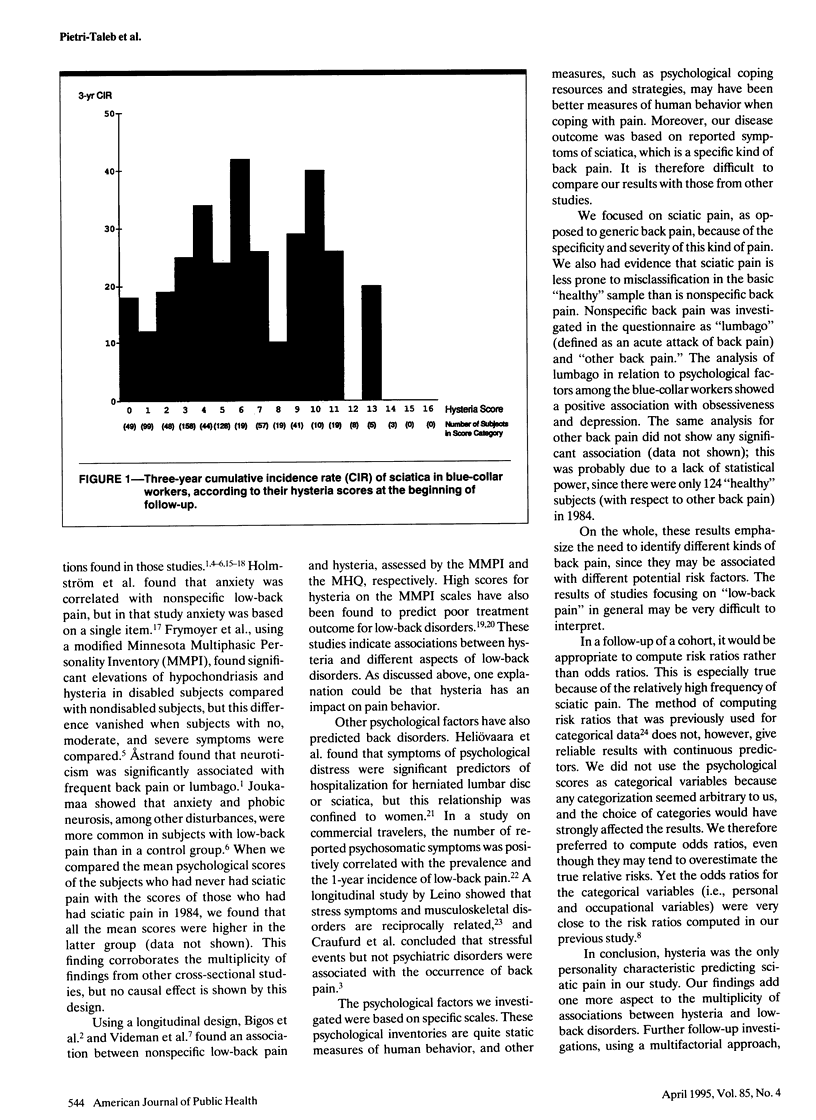Abstract
OBJECTIVES. The role of personality characteristics and psychological distress in the incidence of sciatic pain was investigated in a 3-year prospective study. METHODS. The study population consisted of 1149 Finnish men aged 25 through 49 years (387 machine operators, 336 carpenters, and 426 office workers) with no history of sciatic pain at the beginning of follow-up. The psychological distress and personality characteristics were assessed by the Middlesex Hospital Questionnaire and the Maudsley Personality Inventory. RESULTS. The 3-year cumulative incidence rate for sciatic pain was 22% among the machine operators, 24% among the carpenters, and 14% among the office workers. The multivariate analysis of psychological factors, taking into account individual and occupational factors, showed that only hysteria was significantly associated with the incidence of sciatic pain among the blue-collar workers. Among the white-collar workers, none of the psychological dimensions were associated with sciatic pain. CONCLUSIONS. These results are in accordance with previous relationships found between hysteria and low-back disorders. Further follow-up investigations are needed to elucidate the role of psychological factors in the occurrence of back problems.
Full text
PDF




Selected References
These references are in PubMed. This may not be the complete list of references from this article.
- Astrand N. E. Medical, psychological, and social factors associated with back abnormalities and self reported back pain: a cross sectional study of male employees in a Swedish pulp and paper industry. Br J Ind Med. 1987 May;44(5):327–336. doi: 10.1136/oem.44.5.327. [DOI] [PMC free article] [PubMed] [Google Scholar]
- Bigos S. J., Battié M. C., Spengler D. M., Fisher L. D., Fordyce W. E., Hansson T. H., Nachemson A. L., Wortley M. D. A prospective study of work perceptions and psychosocial factors affecting the report of back injury. Spine (Phila Pa 1976) 1991 Jan;16(1):1–6. doi: 10.1097/00007632-199101000-00001. [DOI] [PubMed] [Google Scholar]
- Craufurd D. I., Creed F., Jayson M. I. Life events and psychological disturbance in patients with low-back pain. Spine (Phila Pa 1976) 1990 Jun;15(6):490–494. doi: 10.1097/00007632-199006000-00011. [DOI] [PubMed] [Google Scholar]
- Crown S., Crisp A. H. A short clinical diagnostic self-rating scale for psychoneurotic patients. The Middlesex Hospital Questionnaire (M.H.Q.). Br J Psychiatry. 1966 Sep;112(490):917–923. doi: 10.1192/bjp.112.490.917. [DOI] [PubMed] [Google Scholar]
- Crown S., Duncan K. P., Howell R. W. Further evaluation of the Middlesex Hospital Questionnaire (M.H.Q.). Br J Psychiatry. 1970 Jan;116(530):33–37. doi: 10.1192/bjp.116.530.33. [DOI] [PubMed] [Google Scholar]
- Frymoyer J. W., Pope M. H., Costanza M. C., Rosen J. C., Goggin J. E., Wilder D. G. Epidemiologic studies of low-back pain. Spine (Phila Pa 1976) 1980 Sep-Oct;5(5):419–423. doi: 10.1097/00007632-198009000-00005. [DOI] [PubMed] [Google Scholar]
- Frymoyer J. W., Rosen J. C., Clements J., Pope M. H. Psychologic factors in low-back-pain disability. Clin Orthop Relat Res. 1985 May;(195):178–184. [PubMed] [Google Scholar]
- Heliövaara M., Knekt P., Aromaa A. Incidence and risk factors of herniated lumbar intervertebral disc or sciatica leading to hospitalization. J Chronic Dis. 1987;40(3):251–258. doi: 10.1016/0021-9681(87)90161-5. [DOI] [PubMed] [Google Scholar]
- Heliövaara M., Mäkelä M., Knekt P., Impivaara O., Aromaa A. Determinants of sciatica and low-back pain. Spine (Phila Pa 1976) 1991 Jun;16(6):608–614. doi: 10.1097/00007632-199106000-00002. [DOI] [PubMed] [Google Scholar]
- Holmström E. B., Lindell J., Moritz U. Low back and neck/shoulder pain in construction workers: occupational workload and psychosocial risk factors. Part 1: Relationship to low back pain. Spine (Phila Pa 1976) 1992 Jun;17(6):663–671. doi: 10.1097/00007632-199206000-00005. [DOI] [PubMed] [Google Scholar]
- Leino P. Symptoms of stress predict musculoskeletal disorders. J Epidemiol Community Health. 1989 Sep;43(3):293–300. doi: 10.1136/jech.43.3.293. [DOI] [PMC free article] [PubMed] [Google Scholar]
- Magora A. Investigation of the relation between low back pain and occupation. V. Psychological aspects. Scand J Rehabil Med. 1973;5(4):191–196. [PubMed] [Google Scholar]
- Pietri F., Leclerc A., Boitel L., Chastang J. F., Morcet J. F., Blondet M. Low-back pain in commercial travelers. Scand J Work Environ Health. 1992 Feb;18(1):52–58. doi: 10.5271/sjweh.1614. [DOI] [PubMed] [Google Scholar]
- Riihimäki H., Viikari-Juntura E., Moneta G., Kuha J., Videman T., Tola S. Incidence of sciatic pain among men in machine operating, dynamic physical work, and sedentary work. A three-year follow-up. Spine (Phila Pa 1976) 1994 Jan 15;19(2):138–142. doi: 10.1097/00007632-199401001-00003. [DOI] [PubMed] [Google Scholar]
- Taylor W. P., Stern W. R., Kubiszyn T. W. Predicting patients' perceptions of response to treatment for low-back pain. Spine (Phila Pa 1976) 1984 Apr;9(3):313–316. doi: 10.1097/00007632-198404000-00017. [DOI] [PubMed] [Google Scholar]
- Videman T., Rauhala H., Asp S., Lindström K., Cedercreutz G., Kämppi M., Tola S., Troup J. D. Patient-handling skill, back injuries, and back pain. An intervention study in nursing. Spine (Phila Pa 1976) 1989 Feb;14(2):148–156. doi: 10.1097/00007632-198902000-00002. [DOI] [PubMed] [Google Scholar]
- Wacholder S. Binomial regression in GLIM: estimating risk ratios and risk differences. Am J Epidemiol. 1986 Jan;123(1):174–184. doi: 10.1093/oxfordjournals.aje.a114212. [DOI] [PubMed] [Google Scholar]
- Wiltse L. L., Rocchio P. D. Preoperative psychological tests as predictors of success of chemonucleolysis in the treatment of the low-back syndrome. J Bone Joint Surg Am. 1975 Jun;57(4):478–483. [PubMed] [Google Scholar]


